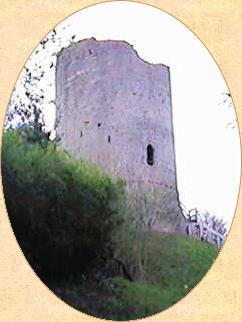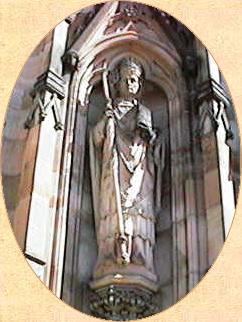
Marcher
Lords

William de Braose, third
Lord of Bramber, succeeded his father Philip in troubled times.
He was involved in one of the strangest events of the civil war
during King Stephen's reign, when the throne was contested by
Henry I's daughter Matilda.
In 1139 Matilda landed
with a force at Arundel. Stephen besieged her at the castle and
could have put an end to her ambitions there and then. But his
chivalric spirit was roused by the lady of the castle, Matilda's
stepmother, Adeliza. She bargained for an end to the siege and
to the continuing astonishment of historians, the king provided
Matilda with an escort to Bristol. From there Matilda relaunched
her long and bloody campaign for the throne. William de Braose
was selected as a member of Matilda's escort.
William
emerged from the civil war in a position of strength and began
the rapid expansion of the family interests in Wales. His marriage
to Bertha, daughter of Miles of Gloucester, earl of Hereford
proved to be an exceptionally fortunate match. Miles died while
hunting in 1143. In 1155 his heir Roger became a monk. Three
further sons died without male heirs, Walter on his way back
from the Holy Land in 1159 and Henry at the hand of a Welsh prince,
Seisyll ap Dyfnwal in 1166. The last, Mahel, was hit on the head
by masonry from the burning castle
of Bronllys within
months of his succession.
Three sisters shared the
inheritance and Bertha took the lordships of Brecon and Abergavenny
for the de Braoses. These, added to the existing family lands
of Radnor and Builth, were a formidable power base in the Welsh
marches. It was the start of a legend in Wales. There
are many fanciful stories about the successive de Braose barons
and their wives and daughters. They committed ferocious atrocities
and wielded breathtaking power in their domains. The family also
suffered some catastrophic falls but made remarkable recoveries.
 William
attended the 1164 council at Clarendon in support of Henry II
during the dispute with Thomas Becket. He went to Ireland with
his younger brother Philip, who made his name fighting with Henry
II. (7.1) Philip held Wexford on the king's
departure in 1172. He was granted north Munster, after others
had refused it, but turned back as he approached Limerick. Philip
failed to take his lands before his death in 1201.
William
attended the 1164 council at Clarendon in support of Henry II
during the dispute with Thomas Becket. He went to Ireland with
his younger brother Philip, who made his name fighting with Henry
II. (7.1) Philip held Wexford on the king's
departure in 1172. He was granted north Munster, after others
had refused it, but turned back as he approached Limerick. Philip
failed to take his lands before his death in 1201.
William de Braose appears
as the king's companion in Dublin at the signing of a charter
in 1173, granting the city to the people of Bristol to inhabit..Scotland
invaded the north in 1173 and the king's own sons fomented rebellion.
During this crisis Henry appointed the tough marcher lord as
his sheriff in Herefordshire. William held the position for a
year until September 1175. His son then took charge of
the Welsh lordships and later, under King John, he extended them
still further. (7.2) This son was also called William
and he married Maud de Saint Valery. The father appears
to have "retired" until his death at an advanced age
shortly before 1193.
A
further grip on the marches developed with the career of Maud
and William's son Giles.
He rose to become bishop of Hereford in 1200, shortly after John
took the throne. The secular and religious power wielded by Giles
and his family later had a decisive influence on the baronial
wars during John's reign.

back to text

back
to text
William de Braose, third Lord of Bramber, succeeded his father Philip in troubled times. He was involved in one of the strangest events of the civil war during King Stephen's reign, when the throne was contested by Henry I's daughter Matilda. In 1139 Matilda landed with a force at Arundel. Stephen besieged her at the castle and could have put an end to her ambitions there and then. But his chivalric spirit was roused by the lady of the castle, Matilda's stepmother, Adeliza. She bargained for an end to the siege and to the continuing astonishment of historians, the king provided Matilda with an escort to Bristol. From there Matilda relaunched her long and bloody campaign for the throne. William de Braose was selected as a member of Matilda's escort. William emerged from the civil war in a position of strength and began the rapid expansion of the family interests in Wales. His marriage to Bertha, daughter of Miles of Gloucester, earl of Hereford proved to be an exceptionally fortunate match. Miles died while hunting in 1143. In 1155 his heir Roger became a monk. Three further sons died without male heirs, Walter on his way back from the Holy Land in 1159 and Henry at the hand of a Welsh prince, Seisyll ap Dyfnwal in 1166. The last, Mahel, was hit on the head by masonry from the burning castle of Bronllys within months of his succession. Three sisters shared the inheritance and Bertha took the lordships of Brecon and Abergavenny for the de Braoses. These, added to the existing family lands of Radnor and Builth, were a formidable power base in the Welsh marches. It was the start of a legend in Wales. There are many fanciful stories about the successive de Braose barons and their wives and daughters. They committed ferocious atrocities and wielded breathtaking power in their domains. The family also suffered some catastrophic falls but made remarkable recoveries.
William de Braose appears as the king's companion in Dublin at the signing of a charter in 1173, granting the city to the people of Bristol to inhabit..Scotland invaded the north in 1173 and the king's own sons fomented rebellion. During this crisis Henry appointed the tough marcher lord as his sheriff in Herefordshire. William held the position for a year until September 1175. His son then took charge of the Welsh lordships and later, under King John, he extended them still further. (7.2) This son was also called William and he married Maud de Saint Valery. The father appears to have "retired" until his death at an advanced age shortly before 1193. A
further grip on the marches developed with the career of Maud
and William's son Giles.
He rose to become bishop of Hereford in 1200, shortly after John
took the throne. The secular and religious power wielded by Giles
and his family later had a decisive influence on the baronial
wars during John's reign.
|
||||